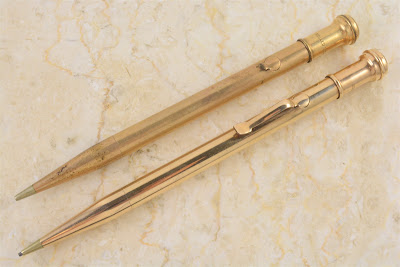This article has been edited and included in The Leadhead's Pencil Blog Volume 5; copies are available print on demand through Amazon here, and I offer an ebook version in pdf format at the Legendary Lead Company here.
If you don't want the book but you enjoy this article, please consider supporting the Blog project here.
The article, “Spots and Dots,” was posted at http://leadheadpencils.blogspot.com/2015/01/spots-and-dots.html and was later expanded and refined into an article which appeared in Summer, 2016 issue of The Pennant, journal of the Pen Collectors of America. The article in The Pennant also addressed a competing theory, that the Mentmore Pen Company, which introduced a line of “Spot Pens” at almost exactly the same time as Sheaffer’s white dot, copied Sheaffer’s dot – or the other way around. I concluded that given both Mentmore and Sheaffer’s proximity to Dunhill offices, both drew their inspiration independently from Dunhill, on opposite sides of the Atlantic.
One of the images from The Pennant article was this advertisement, from the 1929 British Industries Fair catalog:
Since the focus of the article was on the fountain pens – I didn’t want to drive the Pennant’s audience too crazy with pencil talk – I didn’t say anything in the article about that great Spot pencil shown in the advertisement, complete with its round, spotlike clip mounting. When I ran into Jonathan Sternberg at the Baltimore Show in March, 2016, it did my heart good to see this:
Even missing the clip, I knew from that round bit that this must be a Mentmore Spot pencil. There might have been a bit of artistic license in the advertisement, though, since that great imprint is actually on the side opposite the clip
I don’t actively pursue foreign pencils as much as I do American ones, but now that I had found a placeholder for my collection I was eager to find one of these with its clip. Since Jonathan is from across the pond, I asked him how hard it would be to find one, and his response was “good luck.” Apparently these clips are notorious for breaking off.
Good luck, however, is exactly what I had. I received an email a few months ago from Ian Rhodes in Scotland, who was wondering if I could tell him anything about a curious pencil he had found. I emailed him my article from The Pennant and then found a delicate way to suggest that maybe his pencil should find its way to Ohio. Fortunately he wasn’t too attached to it, so a week or so later I had my upgrade:
English pencils weren’t the only things I don’t normally pursue that the “Spots and Dots” piece had me chasing. At the DC show this year, I found myself buying a fountain pen, too:
The pen is marked “Wallace,” a brand marketed by the Inkograph Company which is better known for its stylographic pens. The Wallace name comes from its president and founder, Joseph Wallace; David Nishimura has found evidence that the Inkograph Company might have used the Wallace name on pens sold through the Woolworth’s stores (see http://vintagepensblog.blogspot.com/2015/03/sub-brands-house-brands-and-private.html).
Jim Mamoulides has suggested the Wallace brand was used to denote an open-nib fountain pen rather than the hooded variety (see http://www.penhero.com/PenGallery/Inkograph/InkographInkDCator.htm), and this one fits that profile . . .
although that looks like a Vacumatic nib in there – an upgrade, but I doubt it’s a factory one.
What does appear to be factory, however, is what’s right above the clip:
Sheaffer aggressively and litigiously protected the shape of the Balance, and the company held federal trademark number 217,404 on the white dot used in connection with “pens and pencils.”
So how did this happen?










No comments:
Post a Comment